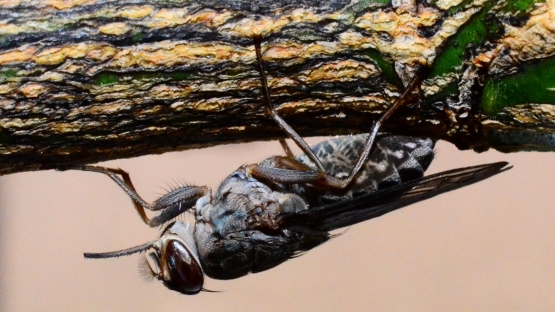Sleeping sickness or Human African Trypanosomosis (HAT) affects people in 37 countries in sub-Saharan Africa and is caused by unicellular parasites known as Trypanosoma brucei gambiense and Trypanosoma brucei rhodesiense. T. b. gambiense is responsible for about 95% of the chronic cases of HAT in Central and Western Africa, whereas T. b. rhodesiense causes the acute form of HAT in Eastern Africa. The parasites are transmitted by blood-feeding tsetse fly species belonging to the genus Glossina. Other Glossina-transmitted trypanosomes also infect cattle and cause a disease called nagana, a Zulu word meaning ‘to be depressed’. Nagana or African Animal Trypanosomosis (AAT) results in substantial economic losses to many countries in sub-Saharan Africa.
Trypanocidal drugs are often used to manage AAT among livestock. However, these are costly and unsustainable due to increased resistance of the parasites to the available drugs. To develop more sustainable approaches to the management of AAT in Africa, several governments have adopted the sterile insect technique (SIT) as part of area-wide integrated pest management approaches to manage populations of the tsetse fly vector. Using this approach, a population of Glossina austeni was eradicated from the Island of Unguja (Zanzibar), in the United Republic of Tanzania in 1997. The SIT relies on limiting the reproductive capacity of the tsetse flies by releasing large numbers of mass-reared sterile males.
To further improve SIT technology, an IAEA Coordinated Research Project (CRP) on ‘Enhancing Vector Refractoriness to Trypanosome Infection’ was initiated in 2013 under the auspices of the Joint FAO/IAEA Division of Nuclear Techniques in Food and Agriculture. The objectives of the CRP were: (1) to gain more in depth knowledge of the tripartite interactions between the tsetse fly vectors, their symbionts, and trypanosome parasites and (2) to acquire a better understanding of mechanisms that limit the development of trypanosome infections in tsetse and how these may be enhanced.
The research activities involved detailed studies of the biology of the insect in relationship to the causative trypanosomes, parasites, and symbionts, as well as epidemiological investigations of the disease in various parts of Africa. The major achievements of the CRP that have enhanced the efficiency of operational field programmes are:
- The full genome sequence of 6 tsetse species was completed.
- Spiroplasma bacteria were identified in some tsetse species for the first time.
- Infection of tsetse species with small iflaviruses was discovered for first time.
- The effects of sterilizing radiation on the microbiota and the cuticular hydrocarbon profile were documented and a new protocol to maintain tsetse symbionts in irradiated males developed.
- New bacteria that block trypanosome infection in tsetse flies were identified.
- Procedures associated with the development of paratransgenic tsetse lines have been optimized.
All the major achievements of the CRP were published in a dedicated Special Issue of BMC Microbiology. This Special Issue provides an important contribution to our knowledge on tsetse flies and their symbionts, parasites, and pathogens. It will provide the insect pathology and symbionts scientific community with increased knowledge about the recent advances made in this field, and contribute to the potential to solve this important problem that continues to affect both humans and cattle in sub-Saharan Africa.




